Dutch Republic Lion
Part of a series on the |
|---|
| History of the Netherlands |
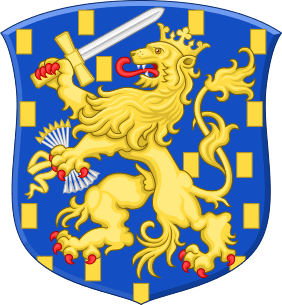 |
|
|
The Dutch Republic Lion (also known as States Lion) was the badge of the Union of Utrecht, the Republic of the Seven United Netherlands and is a precursor of the current coat of arms of the Kingdom the Netherlands.
Origin
Lions are a constant in the heraldic symbology of the Netherlands, so much so that maps of the Netherlands in the past have been shaped as lions with a common nickname "Leo Belgicus".

There are three main heraldic motifs of the Netherlandish lion. The black lion on gold of Flanders (see Coat of arms of Flanders), its inverse the gold lion on black of Brabant, and the red lion on gold of Holland. There is one more lion of note, the red lion on blue and white bars of Luxembourg, as their ruling family sat on the imperial throne as Holy Roman Emperors:
The Flemish lion derives from the arms of the Counts of Flanders. Their first appearance is on a seal of Count Philip of Alsace, count of Flanders from 1168 to 1191, dating from 1163. As such they constitute the oldest of the many territorial arms bearing a lion in the Low Countries. It is said that Philip of Alsace brought the lion flag with him from the Holy land, where in 1177 he supposedly conquered it from a Saracen knight, but this is a myth. However, Count Philip was not the first of his line to bear a lion, for his cousin, William of Ypres, already used a seal with a lion passant in 1158. The simple fact that the lion appeared on his personal seal since 1163, when he had not yet set one step in the Levant, disproves it.
In reality Philip was following a West-European trend. In the same period lions also appeared in the arms of Brabant, Luxembourg, Holland, Limburg and other territories, most importantly England. It is curious that the lion as a heraldic symbol was mostly used in border territories and neighbouring countries of the Holy Roman Empire and France. It was in all likelihood a way of showing independence from the emperor, who used an eagle in his personal arms and the King of France, who used the famous Fleur-de-lis. In Europe the lion had been a well-known figure since Roman times, through works such as the fables of Aesop. In the story about the Guldensporenslag, the arms and its corresponding battlecry Vlaendr'n den leeuw ("Flanders, the Lion!") plays a crucial role in the forming of a Flemish consciousness, which was popularised in recent times by the book De Leeuw van Vlaanderen by Hendrik Conscience. As a result, the arms of the county live on as arms of the Flemish Community.
The Arms of Brabant were first used probably by Count Lambert I of Louvain, the lion is also documented in a 1306 town's seal of Kerpen, together with the red lion of Limburg. Today these arms are used by the Kings of the Belgians.
 Arms of the counts of Flanders
Arms of the counts of Flanders Arms of the dukes of Brabant, now used by the Kings of the Belgians
Arms of the dukes of Brabant, now used by the Kings of the Belgians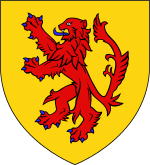 Arms of the counts of Holland
Arms of the counts of Holland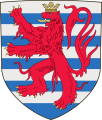 Arms of the dukes of Luxembourg
Arms of the dukes of Luxembourg
These lions are repeated in many arms in the Netherlands, of various noble houses (see Armorial of the Seventeen Provinces of the Netherlands (fr)) and in the arms of other provinces:
 Arms of the Dukes of Gelderland showing the arms of Gelre and Jülich.
Arms of the Dukes of Gelderland showing the arms of Gelre and Jülich.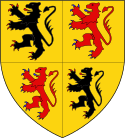 Arms of the Counts of Hainaut quartering Flanders and Holland.
Arms of the Counts of Hainaut quartering Flanders and Holland.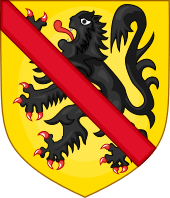 Arms of the Counts of Namur based on the arms of Flanders.
Arms of the Counts of Namur based on the arms of Flanders. Arms of the Counts of Zeeland based on the arms of Holland.
Arms of the Counts of Zeeland based on the arms of Holland.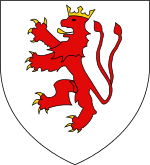 Arms of the Dukes of Limburg based on the arms of Luxemburg.
Arms of the Dukes of Limburg based on the arms of Luxemburg. Arms of Overijssel, based on the arms of Holland.
Arms of Overijssel, based on the arms of Holland.
When the county of Flanders was inherited by the Dukes of Burgundy in 1405, the Flemish lion was placed on an escutcheon in their dynastic arms (see Armorial of the French Royal House or Armorial of Dukes of Burgundy). The same happened with the duchy of Brabant (and its dependent duchy of Limburg) in 1430, but oddly not the county of Holland in 1432. These passed with the rest of the Burgundian inheritance to the House of Habsburg in 1482. Their descendants, the Kings of Spain (see Monarchy of Spain bear the title and arms of the county of Flanders (Holland was renounced in 1648 with the Treaty of Westphalia) and the duchy of Brabant to this day (see Coat of arms of the King of Spain and List of titles and honours of the Spanish Crown).
.svg.png) Arms of the Duke of Burgundy (1404-1430)
Arms of the Duke of Burgundy (1404-1430) Arms of the Duke of Burgundy since 1430
Arms of the Duke of Burgundy since 1430.svg.png) Arms of the Spanish Habsburgs (see House of Habsburg)
Arms of the Spanish Habsburgs (see House of Habsburg).svg.png) Greater Royal Arms of Spain (see Coat of arms of the King of Spain)
Greater Royal Arms of Spain (see Coat of arms of the King of Spain)
The new state created in 1579 with the Union of Utrecht during Eighty Years War did not have its own badge initially. For the first month the States General used the badge of the Duchy of Brabant, because Brabant was the leading region in the Habsburg Netherlands, since it was the most populous one, contained the economic and commercial center of Antwerp of the Netherlands, and the seat of government was there, Brussels. But, the new Governor-General and Generalissimo of the Spanish forces, Alexander Farnese then just prince of Parma, began in 1579 a campaign against the rebellious provinces known as (Parma's Nine Years). While capturing rapidly several cities of Brabant ('s-Hertogenbosch on July 1, 1579, see Schermer Riot) and Leuven and Diest, Antwerp was still the head of the Dutch Revolt. But, this chaos caused Brabant to lose its hegemony in the Netherlands, and the primacy was returned to Holland and Zeeland.[1] At this point, the seal and arms of the state needed another symbol, Dutch Republic Lion.
New States Lion

In 1574 a new heraldic motif was chosen, which was based on the Dutch Lion/Leo Belgicus, a widely recognized and respected heraldic motif in the Netherlands, that combined several of the motifs above. The chosen design was, of course, a lion. Its symbolism was a blend of the coat of arms of the provinces of Brabant, Gelderland (from these two the golden lion was taken) and Holland (whose coat of arms was the opposite). The Dutch Republic Lion had also a sheaf of arrows and a sword, taken from the crest of Charles V in his seal as "Lord of the Netherlands". The sheaf of arrows was intended as a symbol of unity of the provinces of the Netherlands: one for each of the 17 provinces. The sword was meant to symbolize the determination to defend their liberty, and the coronet their sovereignty.[1]
When the seven northern provinces of the Netherlands (The Duchy of Guelders (Gelre in Dutch), the County of Holland, the County of Zeeland, the former Bishopric of Utrecht, the Lordship of Overijssel, the Lordship of Frisia, the Lordship of Groningen and Ommelanden) further united themselves on 23 January 1579 with the Union of Utrecht, these arms were adopted to represent the new union, which became the foundation of the Republic of the Seven United Netherlands (Republiek der Zeven Verenigde Nederlanden). The color pattern chosen initially was a red lion on gold, echoing the arms (see above) of the predominant partner in the new union, Holland. This was inverted in 1665 to a gold lion on red to be more representative of all the provinces of the union. When the provinces of Brabant, Gelderland, Flanders, Holland, Zeeland, Friesland, Mechelen and Utrecht on 26 July 1581 signed the Act of Abjuration declaring their independence from Spain and Philip II, these arms became the arms of the new nation.
The sovereignty of the federal union was emphasized by the title of the States General "their Noble Mightinesses, the Lords States-General" or, in Dutch, "Den Heeren Hoog-Mogenden, Den Heeren Staten-Generaal der Verenigde Provinciën der Nederlanden").[2] and by a crown on the lion in their arms.
.svg.png) Coat of arms of the republic of the united Netherlands (before 1665)
Coat of arms of the republic of the united Netherlands (before 1665).svg.png) Coat of arms of the republic of the united Netherlands (after 1665)
Coat of arms of the republic of the united Netherlands (after 1665)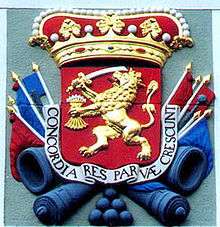 Arms of the "Republic of the Seven United Provinces" (the Netherlands between 1665 - 1795). Relief in Dordrecht
Arms of the "Republic of the Seven United Provinces" (the Netherlands between 1665 - 1795). Relief in Dordrecht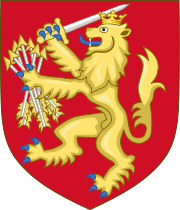 Arms of the Dutch Republic.
Arms of the Dutch Republic.
The number of arrows changed over time. At first there were 17, despite the fact that the Union of Utrecht counted 11 districts after the Fall of Antwerp in 1585. It was hoped by William the Silent that all the Seventeen Provinces of the Netherlands would eventually be united. However, this was not to be, and so it was eventually changed to 11, and with the Reduction of Groningen to 7. The number of arrows on the arms fixed at 7 in 1606, but the seal still remained with 17 arrows until 1795.

Duke of Anjou
At the time of the Dutch declaration of independence the territory under nominal States-General control was steadily shrinking. Parma made steady progress. Orange had already been convinced that the only way to avert total defeat was to regain support of the moderates, alienated by Calvinist radicalism; reassure the still-loyal Catholics in the South; and retain the trust of the German Lutheran princes and the king of France. To attain these objectives he now persuaded the States-General to offer sovereignty over the Netherlands to the younger brother of Henry III of France, François, Duke of Anjou, who in 1578 had already intervened on behalf of the States-General. The latter arrived in Antwerp in January 1581, where he took an oath to in effect govern as a "constitutional monarch", and was acclaimed by the States-General as Protector of the Netherlands.
Unfortunately, Orange's attempt to paper over the disunity within the States-General by bringing in Anjou did not succeed. Holland and Zeeland acknowledged him perfunctorily, but mainly ignored him, and of the other members of the Union of Utrecht Overijssel, Gelderland and Utrecht never even recognised him.[3]
At the time of his sovereignty, Anjou replaced the Generality Lion by arms that he himself designed incorporating all the arms of the, at that time, nine Dutch rebellious provinces with France.
Anjou himself was dissatisfied with his limited power, and decided to take the Flemish cities of Antwerp, Bruges, Dunkirk, and Ostend by force. He decided personally to lead the attack on Antwerp on 18 January 1583. In an attempt to fool the citizens of Antwerp, Anjou asked to be permitted to make a "Joyous Entry" into the city in order to honour them with a parade. As soon as his troopers entered, the gates of Antwerp were slammed shut behind them and the citizen militia attacked them. Anjou barely escaped with his life and nearly his entire army perished, an affair known as the French Fury.[4]
After that the States-General re-established the previous arms.
Batavian Republic

The Batavian Republic founded in 1795 used in its first year the arms of the Dutch Republic, i.e. the Dutch lion or lion with crown, sheaf of arrows and swords. But on May 4, 1796, the Dutch Lion badge was replaced by a free drawing of the Netherlands Maiden around an altar with an anchor, and the States Lion with her.
The substitution in 1801 of the Batavian Republic by the Batavian Commonwealth, whose main feature was a stronger Grand Pensionary acting the part locally of the First Counsul Bonaparte also had its impact on heraldry. On April 12, 1802, it was decided that the new badge of the Commonwealth would be a golden lion on a red field again. The number of arrows that bears the lion in the leg was not established. This remained in use until the Kingdom of Holland was formed in 1806 for Napoleon's brother, installed as King Louis I of Holland.
Kingdom of Holland
Napoleon's brother Louis Bonaparte was installed as King of Holland on 5 June 1806. Originally the arms of the new kingdom were to be like those of the Kingdom of Italy: an eagle bearing a shield, with the arms of the United Netherlands, the lion, now royally crowned. In December 1806, A. Renodi in Paris designed arms quartering the Napoleonic eagle with the lion of the United Netherlands. Around the shield was the French Order of the Grand Aigle. Behind the shield are crossed sceptres, typical for Napoleonic heraldry, and above the shield, Napoleon's star.
A few months later, on 20 May 1807, King Louis (now called "Lodewijk") altered these arms, adding a helmet, leaving out his brother’s star and replacing the Grand Aigle with his own Dutch Order of the Union and the old Dutch devise Eendracht maakt macht ("Unity makes strength") around the shield. Exemplary for the innovation in Napoleon's heraldry are the two hands coming out of clouds from behind the shield holding swords, designating King Louis as Connétable de France.
 Coat of arms of Holland (1806).
Coat of arms of Holland (1806)..svg.png) Coat of arms of Holland (1808).
Coat of arms of Holland (1808).
Kingdom of the Netherlands
When William VI of Orange returned to the Netherlands in 1813 and was proclaimed Sovereign Prince of the Netherlands, he quartered the former Arms of the Dutch Republic (1st and 4th quarter) with the "Châlon-Orange" arms (2nd and 3rd quarter), which had come to symbolize Orange. As an in escutcheon he placed his ancestral arms of Nassau. (See House of Orange-Nassau) When he became King in 1815, he combined the Dutch Republic Lion with the billets of the Nassau arms and added a royal crown to form the Coat of arms of the Netherlands. In 1907, Queen Wilhelmina replaced the royal crown on the lion and the shield bearers of the arms with a coronet and had the phallus of the lion removed.[5]
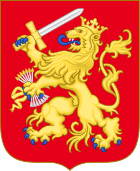 Arms of the States-General of the Dutch Republic. The sword symbolizes the determination to defend the nation, and the bundle of 7 arrows the unity of the 7 United Provinces of the Dutch Republic.
Arms of the States-General of the Dutch Republic. The sword symbolizes the determination to defend the nation, and the bundle of 7 arrows the unity of the 7 United Provinces of the Dutch Republic.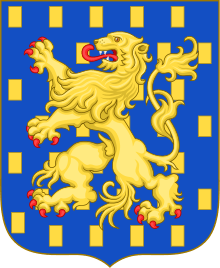 Arms of the House of Nassau, of which the Princes of Orange were a cadet (the Ottonian) branch.
Arms of the House of Nassau, of which the Princes of Orange were a cadet (the Ottonian) branch. Arms of William VI as sovereign prince of the Netherlands.[6]
Arms of William VI as sovereign prince of the Netherlands.[6].svg.png) First arms of the Kingdom and Kings of the Netherlands from 1815 to 1907.[7]
First arms of the Kingdom and Kings of the Netherlands from 1815 to 1907.[7] Arms of the Kingdom and Kings of the Netherlands since 1907.[7]
Arms of the Kingdom and Kings of the Netherlands since 1907.[7]
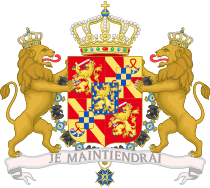 Coat of Arms of the Sovereign Principality and William VI of Orange 1813-1815.
Coat of Arms of the Sovereign Principality and William VI of Orange 1813-1815..svg.png) Coat of Arms of the Netherlands and the Dutch Monarch 1815-1907.
Coat of Arms of the Netherlands and the Dutch Monarch 1815-1907. Coat of Arms of the Netherlands and the Dutch Monarch after 1905.
Coat of Arms of the Netherlands and the Dutch Monarch after 1905.
References
- 1 2 Motley, John Lothrop (1855). The Rise of the Dutch Republic. Harper & Brothers.
- ↑ Rowen, Herbert H. (1978). John de Witt, grand pensionary of Holland, 1625-1672. Princeton University Press.
- ↑ Israel (1995), p. 212
- ↑ see Jean Heritière, Catherine di Medici, Allen and Unwin, p397
- ↑ "Wapens van leden van het Koninklijk Huis". Coats of Arms of the Dutch Royal Family, Website of the Dutch Monarchy, the Hague. Rijksvoorlichtingsdienst (RVD), the Hague, the Netherlands. Retrieved 30 April 2012.
Bij Koninklijk Besluit van 10 juli 1907 (Stb. 181) werd het Koninklijk Wapen, tevens Rijkswapen, aangepast. De leeuw in het schild en de schildhoudende leeuwen droegen vóór die tijd alle drie de Koninklijke kroon, maar raakten deze kwijt nu de toegevoegde purperen hermelijn gevoerde mantel, gedekt door een purperen baldakijn, een Koningskroon ging dragen. De schildhouders waren vóór 1907 bovendien aanziend in plaats van en profiel.
- ↑ Rietstap, Johannes Baptist (2003). Armorial general. vol.2. Genealogical Publishing Co. p. 297. ISBN 0-8063-4811-9.
- 1 2 "The Official Website of the Dutch Royal House in English". Retrieved 26 April 2011.
| Wikimedia Commons has media related to Republic of the Seven United Netherlands. |
Sources
- Gelderen, M. van (2002), The Political Thought of the Dutch Revolt 1555–1590, Cambridge University Press, ISBN 0-521-89163-9
- Glete, J. (2002),War and the State in Early Modern Europe. Spain, the Dutch Republic and Sweden as Fiscal-Military States, 1500–1660, Routledge, ISBN 0-415-22645-7
- Israel, Jonathan (1989), Dutch Primacy in World Trade, 1585–1740, Clarendon Press, ISBN 0-19-821139-2
- Israel, Jonathan (1990), Empires and Entrepôts: The Dutch, the Spanish Monarchy, and the Jews, 1585–1713, Continuum International Publishing Group, ISBN 1-85285-022-1
- Israel, Jonathan (1995), The Dutch Republic: Its Rise, Greatness, and Fall 1477–1806, Clarendon Press, Oxford, ISBN 0-19-873072-1
- Motley, John Lothrop (1855). The Rise of the Dutch Republic. Harper & Brothers.
- Rowen, Herbert H. (1978). John de Witt, grand pensionary of Holland, 1625-1672. Princeton University Press.